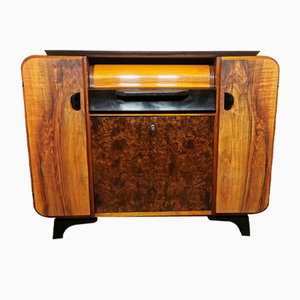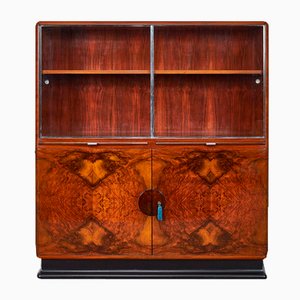
Czech industrial designer, writer, and educator Jindřich Halabala was a significant proponent of modernist, industrially manufactured furniture in Czechoslovakia and had a tremendous influence on the interior design of many interwar and postwar Czech homes.
Born in 1903 in Koryčany, Halabala spent his formative years training as a cabinetmaker in his father’s joinery workshop before entering the state-owned woodworking school in Valašské Meziříčí in 1920. He completed his practical studies with woodworking company Associated Arts & Crafts Enterprises, known as UP (Spojené Uměleckoprůmyslové Závody), in Brno. Halabala subsequently studied at the Academy of Applied Arts in Prague under Czech modernist architect-designer Pavel Janák (1881-1956). After graduating in 1926, Halabala worked briefly at the studio of Bohumil Hübschmann in Prague, until he was hired by UP. Halabala quickly became the firm’s development manager, responsible for product promotion and sales strategy—a position he maintained until 1946. Believing that furniture should be fully functional, modular, mobile, and widely affordable, Halabala advocated for a new mass-market approach to furnishing, ultimately pioneering industrial furniture manufacturing in Czechoslovakia.
Halabala’s designs include chairs, tables, sideboards, drawers, flower stands, couches, lamps, and more, with an aesthetic that drew from Czech Cubism, Art Déco, and classic European mid-century modernism. During the 1930s, he developed the modular series H and E, as well as various types of wooden and tubular steel pieces inspired by Bauhaus designers Mart Stam (1899-1986) and Marcel Breuer (1902-1981). These cantilevered designs, which were produced in UP's Hodonín branch, are highly sought-after today on the vintage market.
Other Halabala designs include the H-269 Lounge Chair (early 1930s)—arguably the most well-known Czech design, instantly recognizable for its exaggerated, curved armrests; the spider-like H-370 Coffee Table (1930s); and the adjustable H-70 Lounge Chair (1930s), to name a few. Like his Scandinavian contemporaries Alvar Aalto (1898-1976) and Bruno Mathsson (1907-1988), Halabala utilized bentwood in most of his chair designs.
Between 1951 and 1954, Halabala was an external lecturer at the Faculty of Forestry & Timber Engineering at VSPD in Kosice, and in 1954, he was appointed professor at the University of Forestry & Wood in Zvolen. He was also a prolific writer, routinely publishing articles in journals as well as the general press. Notably, Halabala was the chairman of the Association of Furniture Manufacturers of Czechoslovakia.
Halabala retired in 1970 and passed away in 1978 in Brno. His designs can be found in the collections of the Moravská Gallery in Brno and the Museum of Modern Art in Olomouc.



